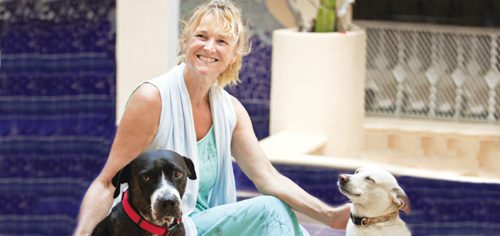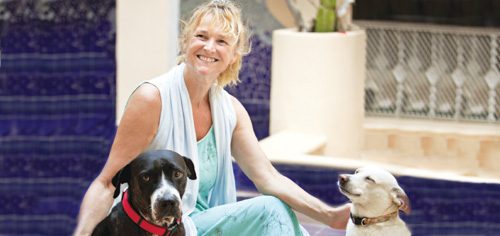

{Todas las Criat uras de Dios} All God’s Creatures: Rescue in Mexico
No one knows how long Wilson had been fighting for his
life, trying to keep his head above water in the ocean off
the coast of Mexico near Cancun. The dog was old, some sort
of small Retriever-cross, and was pretty close to the end of his
struggle when he was plucked from the water by a fisherman.
Infested with ticks, he had nails so long they had curled around
into his paws. His left eye was hopelessly infected and needed to
be removed.
Still, Wilson was lucky. He ended up in
the hands of Alison Sawyer Current and
her organization, Isla Animals, who took
Wilson in, helped him recover then sent
him off to a rescue group in Edmonton
where he is joyfully living with his new
family.
Being a dog in many parts of Mexico is
no easy feat; a combined lack of money,
education, and resources create torturous
and often deadly situations. But Canadians living in Mexico, like
Current, are making a difference, rescuing dogs and helping to
make the country a safer place for our canine companions. Isla
Animals, has rescued more than 5,000 dogs since 1999, including
Karla, a two-year-old Schnauzer, another lucky dog. A school girl
found her lying by the side of the road, not moving. It was clear
she had been thrown there. She was blind, covered in ticks, a
bone rack.
When Karla arrived at Current’s doorstep, she was welcomed,
and with a little bit of care, she started to get fat; too fat. Current
took her to the vet to be spayed, suspecting pregnancy. Instead,
the vet found a tumour and since removal was far beyond his typical
scope of practice, he sewed her back up and returned her to
Current to die at home.
Instead, Current mentioned the tumour to a vet friend in New
York who said “Bring the dog and I’ll take a look.” The “tumour”
turned out to be a chunk of gauze, forgotten
during a spay in Mexico. After a
few weeks in intensive care, Karla got
better and found a new home there. Isla
Animals received a photo of a properly
groomed Karla sitting by the tennis court
with her forever family. It is these stories,
Current says, that allow her the spirit to
continue her work.
Current lives in Isla Mujeres, about
a three-hour ferry ride from Cancun. A
fishing village of around 20,000 people, mostly locals and some expats,
Isla Mujeres is a laid-back community where transportation is
provided mainly by golf carts and mopeds. After retiring, Current
and her husband made the island their permanent home and, once
they saw the plight of the dogs, they found their calling.
“The problem is people don’t honour dogs here like we are
used to,” Current says. “They don’t spend any money on them;
they’re not part of the family. [The dogs] live in front of the house
and have puppies…which are then put in a box and abandoned in an empty lot or taken to the city dump or thrown in the street.”
Current is quick to point out that neglect is a far bigger problem
than cruelty. Some locals, she says, care enough to drop garbage
cans of puppies at her front door to give them a chance at life—
which they get. Puppies are brought back to health and adopted out,
a few to local families, but most are flown, courtesy of Air Transat,
to dog rescue groups in Canada or America, where there are waiting
families.
Current is quick to point out that neglect is a far bigger problem
than cruelty. Some locals, she says, care enough to drop garbage
cans of puppies at her front door to give them a chance at life—
which they get. Puppies are brought back to health and adopted out,
a few to local families, but most are flown, courtesy of Air Transat,
to dog rescue groups in Canada or America, where there are waiting
families.
She worked hard to alleviate the dog problem on her tiny island
and made great strides, but the nearby tourist mecca of Cancun is
far worse, so this is where she devotes most of her energies now.
She worked hard to alleviate the dog problem on her tiny island
and made great strides, but the nearby tourist mecca of Cancun is
far worse, so this is where she devotes most of her energies now.
Twice a year, Current organizes huge spay and neuter clinics,
held at makeshift facilities at a local school. Over a five-day period,
760 animals are spayed and spaces are reserved every day for
street dogs, many of which are trapped specifically for the clinics.
Canadian and American vets fly to Mexico to offer their services and
work alongside some 48 local vets to help develop sustainable skills
for faster, safer, and less invasive procedures, important when most
of the animals worked on are already compromised health-wise and
there’s little post-surgery care.
“Ultimately, the solution is spaying and neutering. In the meantime,
there are horribly hungry and suffering street dogs,” says
Current. “It can break your heart in a thousand different ways.”
Kathryn Purse knows all about the heartbreak. Seven years ago,
she quit her job, packed up, and moved to San Miguel de Allende
in central Mexico.
“I had never seen a dead dog in my life until then,” Purse says.
“You can’t drive down the highway without seeing a lot of dead
dogs. They’re run over constantly. You see ones still alive who are
so skinny; you can see what their fate is.”
Fate, however, also had
something in store for her.
“I found five one-day-old
puppies thrown in a drainage
ditch on the only day there
was no water in it,” Purse
says. “I took them home and
bottle-raised them, and it just
took off from there.”
She now rents a small house on an acre within a 100-acre
ranch and shares her home with 23 dogs. Two hundred dogs have
passed through her doors. Some find their way into wonderful
Mexican families and others go home unexpectedly with tourists.
“They change their plans and fly on airlines that take dogs and
they go home with a dog,” she says. A vet check and rabies certificate
are usually enough to allow the dog to travel.
Purse explains that both Mexican and Canadian mindsets can be
challenging: Mexican, because dead, dying, and starving dogs are
accepted as part of life, and Canadian, because we tend to believe
that whatever the problem is, there are already people who are
helping. In parts of Mexico, she says, there are no people who are
helping.
She isn’t set up to take donations, so when someone offers her
money; she takes the cash—and the person along with her—and
goes to help a dog right that moment. She does encourage tourists
to give money to small organizations like amigos-sma.org, which
work to end the suffering of street dogs and have been successful
in passing some protective laws, such as prohibiting dogs from
being housed on roofs.
“Don’t tell yourself you can’t do it,” she says. She once questioned
whether she was strong enough to help all these dogs, and
has since realized she can do far more than she gave herself credit
for. “If you see a dog on the street and leave it on the street, it
will remain on the street. If we all do a small bit, it would help.
Because I can’t do it all.”
Interested in getting involved? Check out islaanimals.org
Join the newsletter and never miss out on dog content again!
"*" indicates required fields
By clicking the arrow, you agree to our web Terms of Use and Privacy & Cookie Policy. Easy unsubscribe links are provided in every email.